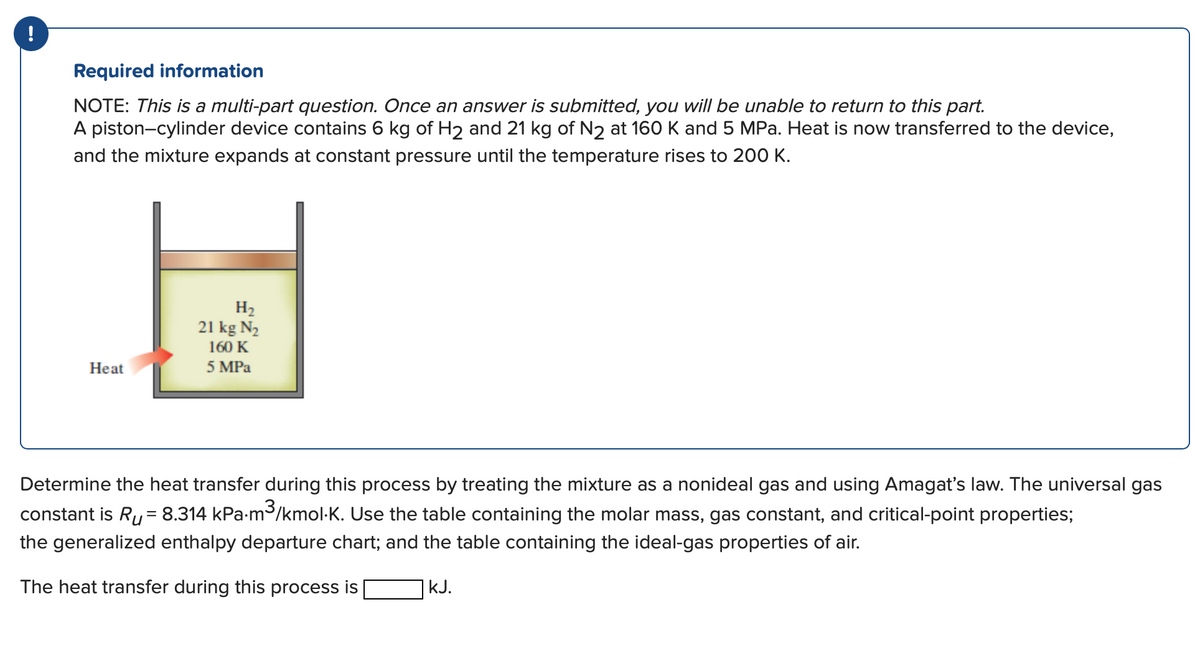! Required information NOTE: This is a multi-part question. Once an answer is submitted, you will be unable to return to this part. A piston-cylinder device contains 6 kg of H₂ and 21 kg of N₂ at 160 K and 5 MPa. Heat is now transferred to the device, and the mixture expands at constant pressure until the temperature rises to 200 K. Heat H₂ 21 kg N₂ 160 K 5 MPa Determine the heat transfer during this process by treating the mixture as a nonideal gas and using Amagat's law. The universal gas constant is R₁ = 8.314 kPa-m³/kmol-K. Use the table containing the molar mass, gas constant, and critical-point properties; the generalized enthalpy departure chart; and the table containing the ideal-gas properties of air. The heat transfer during this process is 1 kJ.
! Required information NOTE: This is a multi-part question. Once an answer is submitted, you will be unable to return to this part. A piston-cylinder device contains 6 kg of H₂ and 21 kg of N₂ at 160 K and 5 MPa. Heat is now transferred to the device, and the mixture expands at constant pressure until the temperature rises to 200 K. Heat H₂ 21 kg N₂ 160 K 5 MPa Determine the heat transfer during this process by treating the mixture as a nonideal gas and using Amagat's law. The universal gas constant is R₁ = 8.314 kPa-m³/kmol-K. Use the table containing the molar mass, gas constant, and critical-point properties; the generalized enthalpy departure chart; and the table containing the ideal-gas properties of air. The heat transfer during this process is 1 kJ.
Elements Of Electromagnetics
7th Edition
ISBN:9780190698614
Author:Sadiku, Matthew N. O.
Publisher:Sadiku, Matthew N. O.
ChapterMA: Math Assessment
Section: Chapter Questions
Problem 1.1MA
Related questions
Question

Transcribed Image Text:!
Required information
NOTE: This is a multi-part question. Once an answer is submitted, you will be unable to return to this part.
A piston-cylinder device contains 6 kg of H₂ and 21 kg of N2 at 160 K and 5 MPa. Heat is now transferred to the device,
and the mixture expands at constant pressure until the temperature rises to 200 K.
Heat
H₂
21 kg N₂
160 K
5 MPa
Determine the heat transfer during this process by treating the mixture as a nonideal gas and using Amagat's law. The universal gas
constant is R₁ = 8.314 kPa.m³/kmol-K. Use the table containing the molar mass, gas constant, and critical-point properties;
the generalized enthalpy departure chart; and the table containing the ideal-gas properties of air.
The heat transfer during this process is
kJ.
Expert Solution
This question has been solved!
Explore an expertly crafted, step-by-step solution for a thorough understanding of key concepts.
Step by step
Solved in 2 steps

Knowledge Booster
Learn more about
Need a deep-dive on the concept behind this application? Look no further. Learn more about this topic, mechanical-engineering and related others by exploring similar questions and additional content below.Recommended textbooks for you

Elements Of Electromagnetics
Mechanical Engineering
ISBN:
9780190698614
Author:
Sadiku, Matthew N. O.
Publisher:
Oxford University Press

Mechanics of Materials (10th Edition)
Mechanical Engineering
ISBN:
9780134319650
Author:
Russell C. Hibbeler
Publisher:
PEARSON

Thermodynamics: An Engineering Approach
Mechanical Engineering
ISBN:
9781259822674
Author:
Yunus A. Cengel Dr., Michael A. Boles
Publisher:
McGraw-Hill Education

Elements Of Electromagnetics
Mechanical Engineering
ISBN:
9780190698614
Author:
Sadiku, Matthew N. O.
Publisher:
Oxford University Press

Mechanics of Materials (10th Edition)
Mechanical Engineering
ISBN:
9780134319650
Author:
Russell C. Hibbeler
Publisher:
PEARSON

Thermodynamics: An Engineering Approach
Mechanical Engineering
ISBN:
9781259822674
Author:
Yunus A. Cengel Dr., Michael A. Boles
Publisher:
McGraw-Hill Education

Control Systems Engineering
Mechanical Engineering
ISBN:
9781118170519
Author:
Norman S. Nise
Publisher:
WILEY

Mechanics of Materials (MindTap Course List)
Mechanical Engineering
ISBN:
9781337093347
Author:
Barry J. Goodno, James M. Gere
Publisher:
Cengage Learning

Engineering Mechanics: Statics
Mechanical Engineering
ISBN:
9781118807330
Author:
James L. Meriam, L. G. Kraige, J. N. Bolton
Publisher:
WILEY